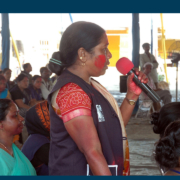Communities Lead the Way to Identify Solutions for Malaria
Siaya County is located along Lake Victoria, one of the largest freshwater lakes in the world. While the lake is a major driver of economic activity, it also significantly impacts residents’ health. Siaya receives plentiful rains throughout the year and has a hot and humid climate, which creates the perfect environment for mosquitoes, which are ever-present in the evenings. Thus, malaria is a major concern. Gregory Ganda, the County Executive Officer for Health, described the situation: “On a day-to-day basis, our health facilities and providers are mainly providing malaria treatment services.”
In nearby Kisumu County, Jeremiah Ongwara, the local Health Promotion Officer, details what he believes is crucial in the fight against malaria in the region around Lake Victoria, “A lot needs to be done to ensure the uptake of malaria prevention behaviors. Insecticide-treated bed nets have been distributed over the years; however, some community members use their nets for purposes other than sleeping, such as for fishing, decorating their houses, and protecting crops,” he said. Despite implementing several malaria prevention strategies, such as mass distribution of insecticide-treated nets, malaria still affects many community members. Nearly one-fifth of all outpatient visits and 15% of all hospital admissions are due to malaria.
Recognizing that collective action and innovative approaches encourage the adoption of malaria prevention behaviors in these communities, Breakthrough ACTION Kenya facilitated a journey mapping process to get community members and health workers talking and involved. Journey mapping helps participants visualize the process that people go through when trying to accomplish a goal. The process identifies issues that hinder them and helps them overcome these challenges.

Participants from Kisumu and Siaya discussing the persona they are developing. Photo by Grace Miheso
Breakthrough ACTION Kenya facilitated a series of meetings, which brought together a diverse group of participants, including community members, local administrative leaders, health workers, health management representatives, and people with disabilities. The meetings’ goal was to understand how people used malaria prevention, testing, and treatment services. Participants defined the challenges and the opportunities. “People with disabilities have been remembered and involved. I have had an opportunity to participate in the generation of solutions and this makes me happy because I know others like me will benefit from the solutions,” said participant Nerea Awino.
Involving community members in this way differs from relying on top-down thinking or expert opinion alone. Here, those who work in health facilities, those who interact with patients, and the patients themselves dictate the problem and their needs and then work together to discover approaches that they feel will improve the situation. “When you involve a diverse group of people, you are able to come up with more ideas for solutions to solve the problems,” said Topister Anyango, a community health volunteer from Kisumu.

Participants from Bungoma and Busia counties developing “how might we…?” statements during an HCD workshop. Photo by: Grace Miheso
Eighteen participants from Bungoma and Busia counties generated solutions for how communities might tackle these challenges. For example, one solution they developed was to recruit “mentor mothers,” women from the community who had gone through malaria in pregnancy or who had taken malaria prevention medication and could speak authoritatively about their experiences to new mothers. Another solution was to develop real-life stories with pictures of actual community members to create a localized and personalized narrative that could increase the emotional impact and relevance of messages. Community health volunteers would disseminate the stories in the form of a photobook as they go door-to-door.
“At the beginning of the meeting, we didn’t understand the process and how this would help us develop solutions, but now it is clear, and it has empowered us because we now own the solutions,” noted Carol Adhiambo, County Community Health Strategy Focal Person for Siaya County. Jacinta Opondo Social and Behavior Change Lead at the National Division of Malaria Program added, “We have designed several health solutions, but this is the first time we have involved communities in the development of the solutions.”
These workshops encompassed the views of all the stakeholders, thereby increasing their likelihood of success. Breakthrough ACTION Kenya will further refine these solutions through additional research and testing. “When I see a solution in the community and identify it as one I was involved in developing, it will make me proud,” said Prescila Atyang, a community member from Bungoma.
Written by: Ronny Nyadgure, SBC Officer, Breakthrough ACTION

 Grace Miheso
Grace Miheso Gopal Bhattacharjee/Photoshare
Gopal Bhattacharjee/Photoshare
 2019 CORE Group Global Health Practitioner Conference
2019 CORE Group Global Health Practitioner Conference WHO
WHO Breakthrough ACTION
Breakthrough ACTION
